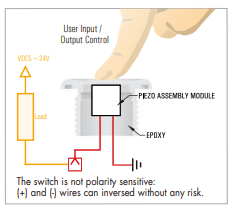The piezoelectric switch consists of a VPM (Versatile Piezoelectric Module) pressed into a rugged metal housing. Piezoelectric element module are components that generate a voltage in response to mechanical stress. Operating according to the “piezoelectric effect,” mechanical pressure (e.g., pressure from a finger) generates a voltage that opens or closes the circuit.
Thus, when pressed, the piezoelectric crystal material produces a corresponding change in voltage that is transmitted to the circuit board through the conductive connecting material, mimicking a dry contact switch closure, relying on the piezoelectric effect to produce a brief “on” state pulse whose duration can vary depending on the amount of pressure applied.
When pressed with higher pressure, higher and longer voltages are also generated. By using additional circuitry and sliders, this pulse can be further extended or changed from an “on” state pulse to an “off” state pulse.
At the same time, it is also a capacitor responsible for storing charge, enabling it to extend the life of the battery. The operating temperature can be in will be between -40ºC and +75ºC. The main feature is the absence of moving parts, such as springs or levers, which makes it stand out from traditional mechanical switches.
The switch’s one-piece construction achieves high performance sealing (IP68 and IP69K) against moisture and dust, making it resistant to damage or external elements. Rated for up to 50 million operations, they are more shock-resistant, waterproof and durable than mechanical switches.
Due to these features, there is zero chance of wear and tear, which extends their service life. and have found applications in a variety of industries. They can be used in transportation, defense, food processing and restaurants, marine and luxury yachts, oil and gas, and the chemical industry.













